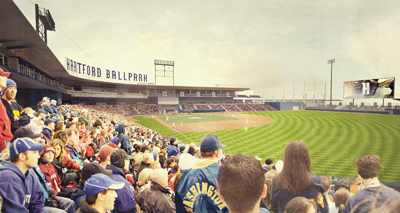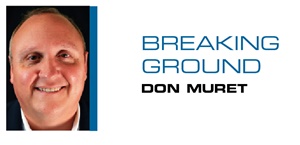The sports development boom tied to mixed-use projects is not exclusive to major league markets. Hartford, Connecticut’s capital and a community of 125,000 residents, is building a minor league ballpark to help revive the city’s downtown.
The $56 million project is the future home of the newly named Hartford Yard Goats, the Colorado Rockies’ Class AA affiliate. The Eastern League team, now the New Britain Rock Cats, will move to Hartford after this season to play in the park, which is targeted to open in April 2016.
It’s part of a $350 million development covering a 50,000-square-foot grocery store, 1,500 housing units, office space and a new location for the Thomas Hooker Brewery Co., a regional microbrewery that has outgrown its original plant in Bloomfield, Conn., according to local reports.
For Pendulum, the Kansas City architect designing the 6,000-seat stadium, the project is one of the largest it has been involved in since the firm started eight years ago, owner Jonathan O’Neil Cole said. Cole was formerly with HNTB, Populous and the former 360 Architecture, now part of HOK.
 |
The 6,000-seat ballpark will be part of a $350 million development.
Photo by: PENDULUM |
Cole specializes in designing minor league facilities, and he says the Hartford redevelopment is similar to
Fluor Field in Greenville, S.C. In that city, the
Field House, a retail, restaurant and office complex with 40 condominiums, sits behind the park’s left-field wall.
In Hartford, the plan is to surround the ballpark with condos around all four corners of the facility, Cole said. In addition, pedestrians outside the stadium on Trumbull Street along right field will be able to see the field from the sidewalk.
Inside the ballpark, Pendulum’s design calls for four rows of 200 outdoor club seats — swivel chairs with drink rails — directly behind home plate. Those seats are supported by a 7,000-square-foot indoor lounge, similar to those at minor league parks in Charlotte and El Paso, Texas, that opened in 2014.
The difference in Hartford is the club bar is not in the middle of the room or near the field facing the glass, Cole said. Instead, it flanks the club entrance above Main Street, providing greater flexibility for weddings and banquets and views of the city skyline and related development.
The two dugout suites at field level both accommodate groups of 50 people. The 18 traditional suites have 16 fixed seats and room for 24 people. Large outdoor party decks are along the left-field and right-field lines.
On the suite level, down the right-field line, are five rows of outdoor club seats stacked over the field in cantilevered fashion, calling to mind the short porch at old Tiger Stadium, Cole said. Catwalks above both bullpens create standing-room destinations.
Pendulum’s design team includes Slam Collaborative and Newman Architects, two firms with Connecticut offices. The owner’s representative is IFG, a company owned by Jerry Reinsdorf, owner of the Chicago White Sox. Project developer CenterPlan is building the ballpark.
The park, a public-private partnership, will be owned and operated by the new Hartford Stadium Authority.
> BIRD OF PREY: The high-tech features tied to the Atlanta Falcons Preview Center extend to some gadgets designed to streamline the sales of premium seats.
The first one, DocuSign, an electronic signature system, allows the buyer to sign digital documents that are produced in a matter of minutes. Legends, the Falcons’ sales agency, can email those cloud-based contracts directly to the customer’s mobile device.
The technology eliminates the need for cumbersome paper contracts that can become a security issue stored in file cabinets, said Michael Drake, Legends’ vice president of sales and service, who is running the preview center.
In addition, Legends’ sales application software includes an electronic “suitcase” feature that uses follow-up emails to track prospects who have visited the preview center but did not buy seats at the team’s new stadium. When the prospect opens the email, a message is sent to a sales representative to re-engage with the individual, leading to faster closing times.
“It’s a little Big Brotherish, but it’s turning out to be a great tool,” Drake said. “Both features are something we’ve never done before. We get a little smarter along the way.”
Don Muret can be reached at dmuret@sportsbusinessjournal.com. Follow him on Twitter @breakground.





